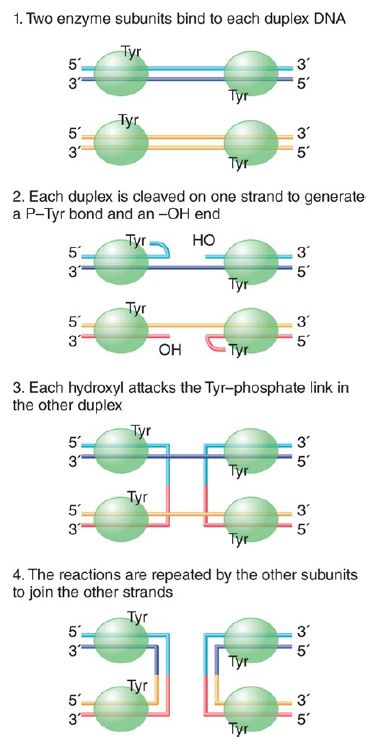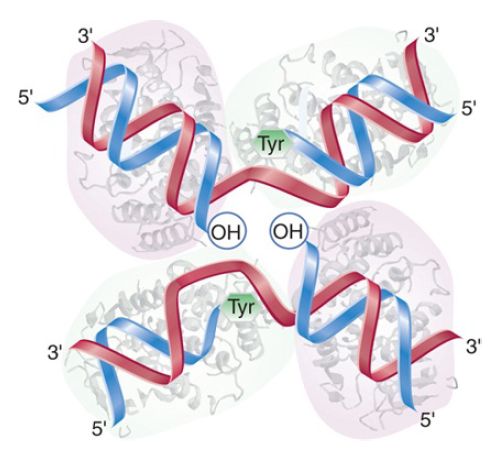
Site-Specific Recombination Resembles Topoisomerase Activity
 المؤلف:
JOCELYN E. KREBS, ELLIOTT S. GOLDSTEIN and STEPHEN T. KILPATRICK
المؤلف:
JOCELYN E. KREBS, ELLIOTT S. GOLDSTEIN and STEPHEN T. KILPATRICK
 المصدر:
LEWIN’S GENES XII
المصدر:
LEWIN’S GENES XII
 الجزء والصفحة:
الجزء والصفحة:
 17-4-2021
17-4-2021
 2168
2168
Site-Specific Recombination Resembles Topoisomerase Activity
KEY CONCEPTS
-Integrases are related to topoisomerases, and the recombination reaction resembles topoisomerase action except that nicked strands from different duplexes are sealed together.
-The reaction conserves energy by using a catalytic tyrosine in the enzyme to break a phosphodiester bond ةand link to the broken 3′ end.
-Two enzyme units bind to each recombination site and the two dimers synapse to form a complex in which the transfer reactions occur.
Integrases use a mechanism similar to that of type I topoisomerases in which a break is made in one DNA strand at a time. The difference is that a recombinase reconnects the ends crosswise, whereas a topoisomerase makes a break, manipulates the ends, and then rejoins the original ends. The basic principle of the system is that four molecules of the recombinase are required, one to cut each of the four strands of the two duplexes that are recombining.
FIGURE 1. shows the nature of the reaction catalyzed by an integrase. The enzyme is a monomeric protein that has an active site capable of cutting and ligating DNA. The reaction involves an attack by a tyrosine on a phosphodiester bond. The 3′ end of the DNA chain is linked through a phosphodiester bond to a tyrosine in the enzyme. This releases a free 5′–OH end.

FIGURE 1.Integrases catalyze recombination by a mechanism similar to that of topoisomerases. Staggered cuts are made in DNA and the 3′–phosphate end is covalently linked to a tyrosine in the enzyme. The free hydroxyl group of each strand then attacks the P–Tyr link of the other strand. The first exchange shown in the figure generates a Holliday structure. The structure is resolved by repeating the process with the other pair of strands.
Two enzyme units are bound to each of the recombination sites. At each site, only one of the units attacks the DNA. The symmetry of the system ensures that complementary strands are broken in each recombination site. The free 5′–OH end in each site attacks the 3′–phosphotyrosine link in the other site. This generates a Holliday junction.
The structure is resolved when the other two enzyme units (which had not been involved in the first cycle of breakage and reunion) act on the other pair of complementary strands.
The successive interactions accomplish a conservative strand exchange, in which there are no deletions or additions of nucleotides at the exchange site, and there is no need for input of energy. The transient 3′–phosphotyrosine link between protein and DNA conserves the energy of the cleaved phosphodiester bond.
FIGURE 2. shows the reaction intermediate, based on the crystal structure. (Trapping the intermediate was made possible by using a suicide substrate like that described for att recombination, which consists of a synthetic DNA duplex with a missing phosphodiester bond so that the attack by the enzyme does not generate a free 5′–OH end.) The structure of the Cre–lox complex shows two Cre molecules, each of which is bound to a 15-bp length of DNA. The DNA is bent by about 100° at the center of symmetry. Two of these complexes assemble in an antiparallel way to form a tetrameric protein structure bound to two synapsed DNA molecules. Strand exchange takes place in a central cavity of the protein structure that contains the central six bases of the crossover region.

FIGURE 2. A synapsed loxA recombination complex has a tetramer of Cre recombinases, with one enzyme monomer bound to each half site. Two of the four active sites are in use, acting on complementary strands of the two DNA sites.
The tyrosine that is responsible for cleaving DNA in any particular half site is provided by the enzyme subunit that is bound to that half site. This is called cis cleavage. This is true also for the Int integrase and XerD recombinase. The FLP recombinase cleaves in trans, however, which involves a mechanism in which the enzyme subunit that provides the tyrosine is not the subunit bound to that half site, but rather is one of the other subunits.
 الاكثر قراءة في مواضيع عامة في الاحياء الجزيئي
الاكثر قراءة في مواضيع عامة في الاحياء الجزيئي
 اخر الاخبار
اخر الاخبار
اخبار العتبة العباسية المقدسة


